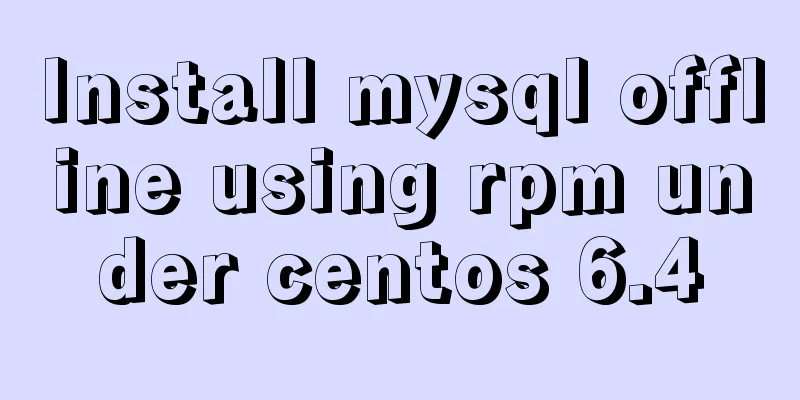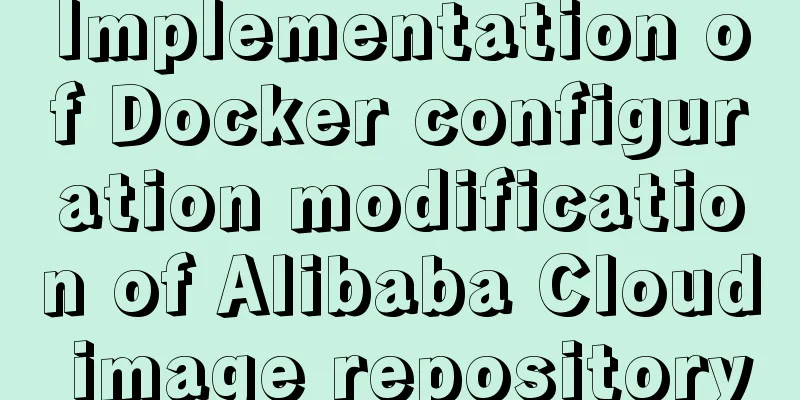Install mysql offline using rpm under centos 6.4

|
Use the rpm installation package to install mysql offline, just for your reference Preparation: Download the MySQL offline rpm installation package from the official website (I won’t demonstrate it here, I’ll just use the existing one for demonstration)
Uninstall and clean up the remnants of previous MySQL installation and uninstallation 1. Detect and uninstall MySQL installed on this machine rpm -qa|grep -i mysql
The noarch one is the source address package, it is the same even if it is not installed 2. As shown in the figure above, MySQL has been installed in the system. Uninstall it: [root@hellxz ~]# yum remove mysql Then execute the first step again to check whether MySQL is installed. If so, you can directly uninstall it by adding the package name you just found with yum remove. 3. Check whether the /var/lib/mysql folder exists. If so, please delete it. It contains the remaining MySQL database. If you do not delete it, the newly installed MySQL will not create a new database. If so, delete rm -rf /var/lib/mysql Install mysql 1. Upload the previously downloaded RPM package to centos and install it, first installing the server. rpm -ivh mysql-community-server-5.6.26-2.el6.i686.rpm
The above picture shows a normal installation. Please ignore the following issues if the installation is normal. 1.1 There may be problems here, as shown in the figure below. When this happened, I was very entangled for a while. In the end, I added the package name that was not installed to yum install. Strangely, it was installed without much traffic. . . The original package says 215M, but mine shows less than 5M...very weird
2. Then the client should be installed, but I reported missing dependencies, so I have to install something else first. . Here is my installation method: rpm -ivh mysql-community-common-5.6.26-2.el6.i686.rpm rpm -ivh mysql-community-libs-5.6.26-2.el6.i686.rpm rpm -ivh mysql-community-client-5.6.26-2.el6.i686.rpm 3. Start the MySQL service after the installation is complete: #Don't ask me why I added d, it may be a different version service mysqld restart 4. Change the default password: #-u is followed by the username, and root is followed by the password. Modify as appropriate /usr/bin/mysqladmin -u root password 'root' 5. Open the mysql command line: #There is no space after -u, just add the username, and after entering this, you will be prompted to enter the password mysql -uroot -p 6. Remote connection authorization (not required for local use): #Authorization: the @ before is the user name, the by after is the password GRANT ALL PRIVILEGES ON *.* TO 'root'@'%' IDENTIFIED BY 'root' WITH GRANT OPTION; 7. Use navicat to connect to the mysql experiment in the virtual machine:
8. If step 7 appears
Please turn off the firewall in centos and temporarily turn off the code: Disable the firewall command: service iptables stop Permanently turn off the firewall: chkconfig iptables off
End of tutorial. The above is the full content of this article. I hope it will be helpful for everyone’s study. I also hope that everyone will support 123WORDPRESS.COM. You may also be interested in:
|
<<: Detailed explanation of the basic use of centos7 firewall in linux
>>: CocosCreator classic entry project flappybird
Recommend
MySQL 8.0.13 download and installation tutorial with pictures and text
MySQL is the most commonly used database. You mus...
How to convert a string into a number in JavaScript
Table of contents 1.parseInt(string, radix) 2. Nu...
Analyze how a SQL query statement is executed in MySQL
Table of contents 1. Overview of MySQL Logical Ar...
【Web Design】Share E-WebTemplates exquisite foreign web page templates (FLASH+PSD source file+HTML)
They are all web page templates from the foreign ...
Let's talk about parameters in MySQL
Preface: In some previous articles, we often see ...
Detailed explanation of HTML document types
Mine is: <!DOCTYPE html> Blog Garden: <!...
Detailed explanation of setting up DNS server in Linux
1. DNS server concept Communication on the Intern...
Basic notes on html and css (must read for front-end)
When I first came into contact with HTML, I alway...
Vue implements seamless scrolling of lists
This article example shares the specific code of ...
MySQL calculates the number of days, months, and years between two dates
The MySQL built-in date function TIMESTAMPDIFF ca...
How to clean up the disk space occupied by Docker
Docker takes up a lot of space. Whenever we run c...
MySQL string splitting operation (string interception containing separators)
String extraction without delimiters Question Req...
Tutorial on using the hyperlink tag in HTML
The various HTML documents of the website are con...
jQuery implements nested tab function
This article example shares the specific code of ...
Modify the style of HTML body in JS
Table of contents 1. Original Definition 2. JS op...
















